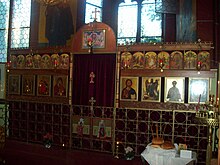Katharinenspital (Aschaffenburg)
The St. Katharinenspital in Aschaffenburg was built between 1604 and 1610, the chapel was consecrated in 1618, destroyed in the Second World War and rebuilt. Today it serves as the church of the Greek Orthodox parish of St. Catherine (Greek: Hagia Ekaterini / Katerina).
history
hospital
A Heiliggeistspital has been mentioned on the Main Bridge outside the city fortifications since the middle of the 13th century . In the following century it was called Elisabethenspital and a new building was built between 1508 and 1511. At the beginning of the 17th century, a new hospital, a little higher up (flood of the Main), was built in Löhergraben not far away. Under the patronage of St. Catherine of Alexandria , the Katharinenspital served as a beneficiary hospital, while the Elisabethenspital remained as a hospital for the poor. Badly damaged by floods and ice in 1766, it was laid down. The sick came to the Katharinenspital.
chapel
The Chapel of St. Catherine was consecrated in 1618, and in 1766 St. Elisabeth became co-patroness of the chapel.
The chapel, built under the supervision of the Aschaffenburg palace builder Georg Ridinger , by the master masons Heinrich Hasenstab and Cyriakus Heymüller, is located on the narrow eastern side of the hospital complex. A rectangular room with a choir that jumps out on three hexagonal sides. Arched choir arch , flat ceilings, wooden gallery on the west side, the windows ogive, tracery partly with fish bladders , ogival portal on the north side with bars and throats. The entrance to the sacristy comes from the previous building Herberge zum Schuh and bears the date 1544. A slate roof turret with a pointed helmet crowns the building.
A small baroque winged altar dates from the early 17th century , the altarpiece - a burial of Christ according to Tintoretto, probably painted by an Italian Dutchman - is flanked by two Tuscan columns; Passion scenes are depicted on the inside of the wings and scenes from the life of St. Elisabeth on the outside. A small tabernacle is built into the predella . The top of the altar, a broken gable with a carved crucifixion group ( Christ on the cross, including Mary (mother of Jesus) and John (apostle) ). Since the altar gives no reference to the patroness of the hospital and the chapel, St. Catherine, it is assumed that it comes from the chapel of the Elisabeth Hospital and that it was installed here after it was laid down.
The north side altar shows a nativity scene , alabaster relief , a work by Johannes (Hans) Juncker not documented, but stylistically authenticated. The southern side altar, three wooden figures, height 1.20 m, Mary with child around 1525, St. Elisabeth around 1525, probably also from the old Elisabeth Hospital and St. Katharina around 1624.
In 1944/45 the Pfründnerheim (rear building) was totally destroyed, the front building with chapel almost completely destroyed, with the altar and figures being recovered and exhibited today in the monastery museum; the alabaster relief is in the Junkersaal of the castle museum.
The enclosing walls were provided with an emergency roof in 1962. Plans for a memorial for the victims of the Second World War as a starting point for a new access to the park (abandoned old town cemetery) were discussed and rejected.
Orthodox chapel
In 1975, at the request of the Greek Orthodox community, the city council left the chapel as a place of worship.
Reconstruction work began in the spring of 1978, the chapel was given a steep sloped hipped roof, the Gothic tracery of the windows was supplemented, and the interior was plastered while preserving the original color scheme that was still preserved, an altar block and a wrought-iron grille that symbolizes the iconostasis (icon wall) and a wooden gallery was built in, as well as a sacristy and sanitary facilities facing the mountainside. On July 28, 1979, the chapel was handed over to the Greek Orthodox community in a solemn service. After additions according to the liturgical specifications, the church was consecrated.
This chapel was consecrated on May 4, 1980 by Metropolitan Irineus and Archpriest of the Ecumenical Patriarchate of Constantinople Antonios Maroussis of Saint Catherine as a Greek Orthodox Church.
A plaque at the entrance to the chapel records this event in German and Greek.
In the following years the church was decorated with icons and other cult objects.
Individual evidence
- ↑ Martin Balduin Kittel, records
- ↑ Felix Mader : The art monuments of the Kingdom of Bavaria . Lower Franconia XIX, City of Aschaffenburg / Munich 1918.
- ↑ Alois Stadtmüller: Aschaffenburg after the Second World War . Destruction, reconstruction, memories. Paul Pattloch Verlag, Aschaffenburg 1973, ISBN 3-557-92047-X .
- ↑ Main-Echo No. 104 of May 6, 1961
- ↑ Main-Echo No. 234 of October 11, 1978
- ↑ Alois Grimm: Aschaffenburg house book . Volume II:… old town between Dalbergstrasse and the castle, Mainufer - Mainbrücke - Löherstrasse with the collaboration of Monika Ebert, Peter Fleck, Ernst Holleber, Ilse Meißner and Alois Stadtmüller. Geschichts- und Kunstverein eV, Aschaffenburg 1991, ISBN 3-87965-053-5 .
- ↑ Main-Echo No. 165 of July 27, 1979
Web links
Coordinates: 49 ° 58 ′ 17.7 " N , 9 ° 8 ′ 39.7" E



